If you think your marketing strategy and marketing department are not producing the desired results, you might take a look at the role of marketing operations.
By taking a bird’s eye view from a marketing operations perspective, you will be able to spot redundancies, cost issues or a lack of technical and analytical skills, which keep your marketing department from excelling.
Therefore, the following article gives you actionable insights into how to analyze your marketing operations from a macro perspective. You will have all the tools necessary to streamline your marketing processes, operate efficiently and build a strong foundation for all your marketing organizations.
What is marketing operations?
Marketing operations is a very broad term that is used to refer to all the elements that come together to ensure efficient, high-performing, and consistent marketing results.
Marketing operations is made up of elements, such as analytics and reporting, marketing automation, technology, compliance, campaign and strategic planning, and more.
Those factors combine to serve as the backbone of marketing. They work together, in harmony, to deliver end-to-end marketing optimization that improves efficiency and, ultimately, realizes the desired marketing results.
Why does your team need marketing operations?
Companies of all sizes can profit from a marketing operations manager and marketing operations team. First of all, the marketing ops team will increase efficiency by streamlining your processes, so that all your hired staff in the marketing department can produce more high-quality output.
Next to simplified workflows, marketing investments will achieve higher ROIs, which in turn increases revenue and/or cuts expenses. Further, marketing ops managers make use of the right technology to achieve data transparency throughout the entire organization. Therefore, even your in-house project managers or financial analysts can profit from smoothly-run marketing ops.
As a last point, marketing ops can help you establish an efficient and reliable performance measurement system for dedicated marketing operations.
How do you structure a marketing operations team?
Don’t make the mistake of confusing marketing operations with a marketing strategy or individual marketing efforts. These parts differ a lot and fulfill different purposes within marketing departments.
What do marketing operations specialists do? Traditional marketing skills rely on strategic and creative thinking to achieve higher sales through an improved customer experience/customer journey. Marketing operations, on the other hand, aim at establishing proper processes to support campaign planning and operations.
This is what makes marketing operations important: The marketing operations team is responsible for the overall structure (the “big picture”), while the regular marketing team serves the formal role of advertising products, services and brand recognition throughout all marketing channels.
Large technology companies have their own marketing operations department with dedicated marketing operations talent, such as a marketing ops specialist. Marketing teams in smaller companies usually do not have a dedicated marketing operations role. The marketing operations role in smaller companies is usually filled by company-wide operations managers.
The following sections describe marketing operations roles within the marketing function of large companies:
- Marketing operations manager: Marketing operations managers (marketing ops managers) or even an entire marketing ops team are responsible for creating proper processes. They are responsible for strategic decisions regarding the right technology infrastructure, such as marketing automation platforms and brand compliance.
- Data and analytics manager: Data and analytics managers (often referred to as market researchers) turn raw data into actionable insights and give the entire marketing and sales teams a better understanding of their customers.
- Content/process manager: Content manager is a hands-on job description and usually refers to team members inside a marketing team, who handle multiple content-related marketing campaigns. They juggle between copywriters, designers and other stakeholders, to deliver specific project outcomes.
- Demand generation specialist: This specialist job description is all about qualified leads generation. A demand generation specialist acts as a bridge between the marketing and sales teams. Driving demand (for instance, through email marketing campaigns) is the most important KPI of the role.
- Marketing technology manager: Technology managers have different skill sets than other team members. Usually, they assist marketing operations managers in choosing the right technology for the marketing team (or even the entire organization).
Depending on your organizational structure, your marketing team might look as follows:
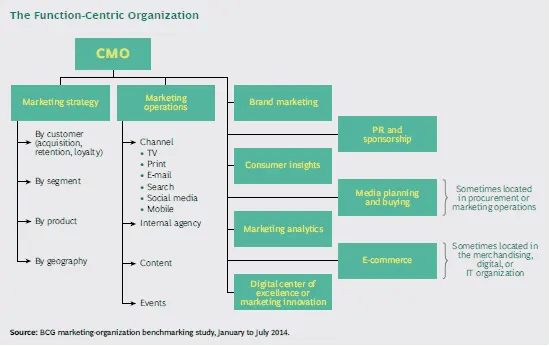
Main segments of marketing operations
Now that we’ve given you a clearer definition of marketing operations, let’s zoom in and take a closer look at its main components.
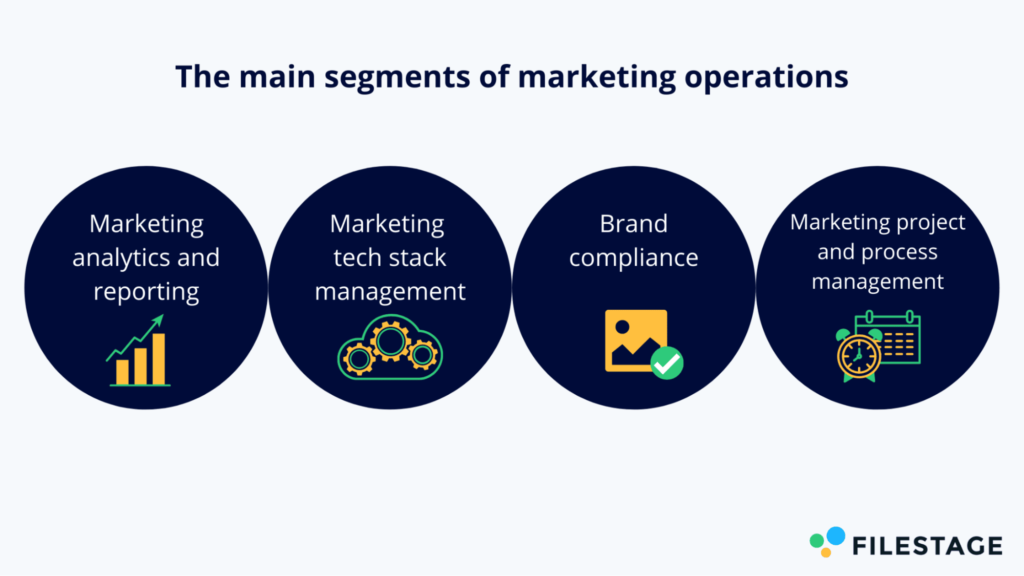
1. Marketing analytics and reporting
In order for marketing operations to be able to guide a wide range of marketing activities effectively, it needs to include sophisticated analytics and reporting. Once these activities have been correctly managed, marketing operations professionals can sort through the resulting data, to assess performance, forecast results, and make important decisions for the marketing team.
Typical marketing analytics and reporting tasks
Some of the typical marketing analytics and reporting tasks that you’ll need to complete on a regular basis are:
- Preparing a range of reports to gauge performance
- Creating dynamic dashboards to present information in new ways
- Presenting key findings to stakeholders
- Using analytics to forecast future performance
- Diagnosing changes in performance
- Using analytics to shape future actions
Best practice checklist
We’ve compiled a list of best practice tips that you’ll want to follow, where analytics and reporting are concerned. This simple checklist will help you to shape your activities.
Monitor the right metrics
You’ll need to monitor metrics, depending on your campaign, and they will vary from one campaign to the next. Ensure you identify the appropriate metrics for each campaign and make sure to track them diligently over time. Some examples of various campaigns could include:
- Email marketing
- Social media
- PPC
- SEO
- Content marketing
- Offline marketing
Use custom dashboards
With so much data out there, and so many KPIs to track, it’s easy to get distracted and to become confused. The most effective marketing operations professionals are able to create custom dashboards, using sophisticated reporting tools. These dashboards help them work as efficiently and effectively as possible.
2. Marketing tech stack management
Sourcing, managing, and maintaining the right tools is a critical part of Marketing Operations success. It’s no easy task, though, given that new tools emerge on a regular basis and small updates can affect the balance of your tech stack.
Typical marketing tech stack management tasks
The most common tasks in tech stack management are:
- Assessing the suitability of new tools
- Updating and maintaining existing tools
- Managing accounts/permissions
- Troubleshooting and contact support
Best practice checklist
Once again, we’ve compiled a list of best practice tips that you’ll want to follow, to improve your tech stack management activities.
Avoid overlapping
Marketers use an average of 12 different tools at any one time, and some can use up to 31 tools, to manage their campaigns and data. That means the potential for overlapping functionality is high, and this can affect the profitability of your projects.
Make sure you use distinct tools and avoid paying twice for the same functionality. Ask yourself, why would I buy something I already have and (therefore) won’t use?
Plan for long-term stability
The trick to tech stack management is to keep an eye on the future and to plan for upcoming needs. Try to develop a roadmap, which will help you to incorporate new tools and features seamlessly, as they arrive.
Without this planning, you might find that your tools don’t play nicely together, which can lead to much confusion.
3. Brand compliance
Marketing departments today have a higher output than at any other point in history, but they’ve still got to be very careful when it comes to compliance. Marketing operations professionals are responsible for ensuring that all marketing collateral is compliant with internal and external guidelines.
Typical brand compliance tasks
The key tasks that make up this area of Marketing Operations are:
- Reviewing and approving creative content
- Securing approval from key decision makers
- Sourcing a number of review and approval tools

Best practice checklist
Brand compliance is a tough area of Marketing Operations. Some of the best practice tips that you can use to succeed are:
Develop a review and approval workflow
First things first; you’ll want to develop a smooth review and approval workflow and incorporate it into your projects. This workflow can help you to work in a methodical way and ensure that you never skip the compliance stage.
Use stakeholder management to keep everyone in the loop
Stakeholder management can ensure that you never leave compliance to chance. When you involve the appropriate people in your projects, you cover all your bases. For more information, read our ultimate guide to stakeholder management for your marketing projects.
4. Marketing project and process management
Marketing projects often involve a number of stakeholders and they can be incredibly complex. If you’re going to get the best results from your marketing endeavors, while keeping your team happy and productive, you’ll need to engage in marketing projects and process management.
Typical marketing project and process management tasks
Some of the main marketing project and process management tasks you’ll encounter on a regular basis are:
- Stakeholder management
- Creation and implementation of workflows
- Collecting and processing feedback
- Onboarding new clients
- Spinning up new projects
Best Practice Checklist
Marketing project and process management is a delicate science. You’ll need to stay on top of the new techniques, tools, and best practices if you want to succeed. Some of the key best practice tips that you can follow are:
Use the right software
Marketing project and process management can quickly become very complex, particularly when there are dependencies between team members. A robust stack of project management tools can transform your projects for the better.
Required skills in marketing operations (and how to build them)
Do you want to enhance your own marketing operations skills or recommend a killer resource to a member of your marketing operations team?
Try to build up and use the following seven, critical marketing operations skills over time.
1. Data management
Marketers handle more data today than they have at any other point in time, and larger volumes of data mean that collecting, storing, and managing it can be quite a challenge.
However, according to Econsultancy and IBM, it’s entirely worth it. They reported that 33% of elite marketers said that having the right technologies for data collection and analysis was invaluable when it came to understanding customers.
If you’re going to make the most of your data – and meet the requirements of emerging legislation, such as the GDPR – you’ll need to boost your data management skills.
Resources to improve your data management skills:
- Enterprise data management – Indiana University
- Which marketing data management solution should you choose? – CMSWire
- Everything you need to know about data management – HubSpot
- How does a data management platform work? – Gartner
2. Analysis and reporting
If marketing operations are the backbone of marketing, data is undoubtedly its lifeblood. Swathes of rich data – and, more particularly, the ability to sort through it – can give marketing teams the power to accomplish just about any project.
This table from DemandGen does a great job of showing how data is at the core of every modern marketing task.
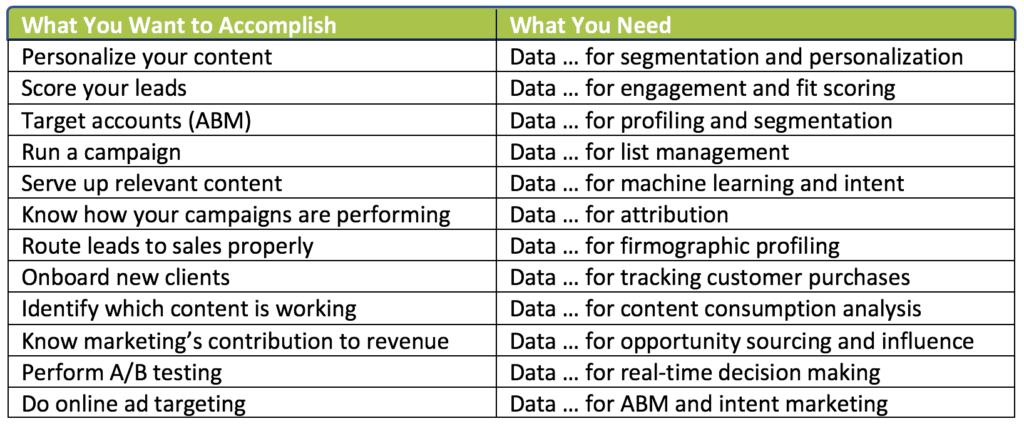
In light of the data presented in this table, 64% of marketing executives “strongly agree” that data-driven marketing is crucial to success in a hypercompetitive global economy.
Resources to improve your analysis and reporting skills:
- Marketing analytics: Data tools and techniques – Wharton University of Pennsylvania
- Advanced web analytics certification training – MarketMotive
- The Moz Academy
3. Tech skills
There is a lot of marketing operations software out there. There are also all sorts of tools, to help with a wide range of marketing tasks and give marketers the power to work more efficiently and effectively.
Those tools can help with things, such as content creation, data management and much more.
However, in order to get the best from these tools, marketers must learn to get the maximum impact from their tools quickly. This often means improving your overall tech and IT skills.
Resources to improve your tech skills:
- 7 Tech skills every digital marketer needs to know – skillcrush
- Six technical skills every marketer needs to stay ahead – Udemy
- Four must-have technical skills for marketers – TechRadar
4. Project management
Managing projects is a huge part of marketing operations, yet only 58% of organizations fully understand its value.
You’ll need to nourish your abilities if you want to guide complex marketing projects to completion flawlessly and keep your team members happy. That’s no easy task, of course, but there are training resources that can give you a helping hand.
Resources to improve your project management skills:
- Project management in marketing: Enhance your marketing career – Oxford Learning Lab
- 11 easy ways to improve your marketing project management – Convince and Convert
- Diploma in project management – Alison
Get started with your marketing operations strategy
Now that you understand the main parts of the marketing operations process – and the key skills that are required – let’s take a look at a step-by-step process you can follow, to build a winning marketing operations strategy.
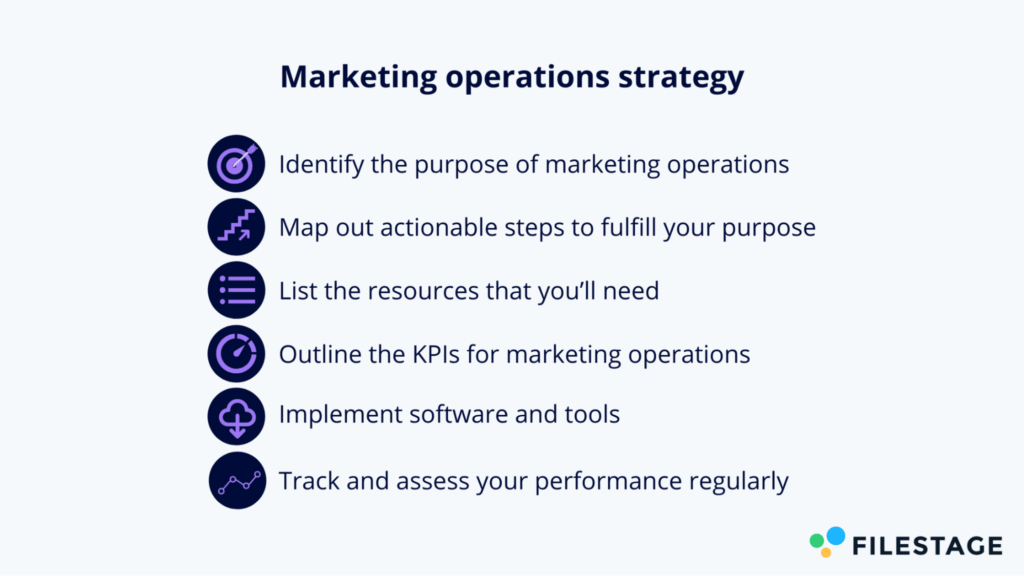
1. Identify the purpose of marketing operations
You’ll need to build upon a solid foundation if you want to shape your marketing operations strategy effectively. This means that you should start by investing the time required, to identify the purpose of your marketing operations activities accurately.
You might want to do this by creating a small positioning statement for the division. It could look something like this:
“Marketing operations will work to harmonize marketing activities, create alignment, and drive efficiency. MO will create the work systems and workflows that will lead to compliant, timely, and effective marketing.”
2. Map out actionable steps to fulfill your purpose
As marketing operations can encompass a wide range of different tasks, it is the role of the marketing operations manager to establish clear and actionable milestones.
This is easier said than done, as the marketing operations team needs a thorough overview of all marketing processes involved: How is a marketing campaign usually structured? How can marketing automation support and foster traditional marketing skills?
These, and many more questions, need to be asked to establish a clear roadmap to successful marketing operations management. Further, marketing operations do not work in silos but need to establish a solution, which the marketing team, sales, and all other stakeholders can agree upon.
Therefore, establishing proper milestones can take a significant amount of time, which should be planned well ahead.
3. List the resources that you’ll need
Now that you have a clear and ambitious positioning statement ready, you’ll find it easier to list the resources that your marketing operations team is going to need.
Give yourself the time to do this. Think about it carefully and use the four areas of marketing operations to guide your thoughts/decisions. We gave you some inspiring examples for the key resources earlier, so your list might look something like this:
- Analytics and Reporting
- Reporting tools
- Guidelines
- Data visualization software
- Tech Stack Management
- Tech roadmap
- A suite of tools
- Compliance
- Templates and outlines
- A review and approval platform
- Project and process management
- Communication tools
- Templates and outlines
4. Outline the KPIs for marketing operations
Now that you have a clear statement and a list of the resources you’re going to need, it’s time to think about how you’ll measure the efficacy of marketing operations.
To do this, you’ll need a list of handy KPIs. You should track these KPIs diligently. Ensure that you choose a range that gives you a clear picture of the performance of marketing operations in different areas.
Here are some, but not all, of the KPIs you could use to measure the efficacy of marketing operations:
- Cost per lead
- Marketing output
- Marketing ROI
- Revenue per employee
5. Implement software and tools
Now the appropriate planning and groundwork are in place, it’s time to select and implement your chosen tools. Of course, the length and complexity of this step will vary, according to the stack you’ve chosen.
Your marketing tech stack can make or break your marketing operations initiative, so ensure you give yourself an appropriate amount of time to set everything up correctly.
Document the important steps in your knowledge base comprehensively, and consider using a password management tool, such as LastPass or NordPass, to harmonize your team at the same time as keeping your marketing operations secure.
6. Track and assess your performance regularly
Now that your marketing operations are up and running, it’s time to work hard to drive value across your marketing department. It’s critical that you use your KPIs to monitor the impact of your marketing operations activities.
Ensure that you schedule regular review sessions, where you can guide your marketing operations, and drive further value, as it continues to grow over the years.
Marketing operations software and templates to simplify your daily work
Technology changes how a team works and can help both small and large companies achieve better results. Therefore, the following section gives you actionable insights into how your marketing organization can improve processes, with the help of specialized software solutions.
1. Marketing analytics and reporting
Data analysis is an indispensable factor when it comes to exploiting customer data. Templates and analytical tools support your marketing operations teams to digest and analyze customer data.
Monthly marketing reporting template – HubSpot

Marketing analytics and reporting can be intimidating, but this template from HubSpot gives you some serious inspiration and a good head start. It comes in a variety of file formats and helps marketers track monthly growth and performance.
Google Analytics

Google Analytics is the world’s foremost web analytics service. It empowers marketers to track websites, blogs, and advertising ROI. The tool also boasts a range of predetermined and highly-customizable reports.
Key features
- Traffic reporting
- Conversion tracking
- Custom dashboards
2. Marketing tech stack management
As already mentioned, one huge task of marketing operations teams is to establish the technological framework, such as the choice of the right marketing automation platform. The following tools help you manage your tech stack.
Marketing technology stack diagram – Demand Metric
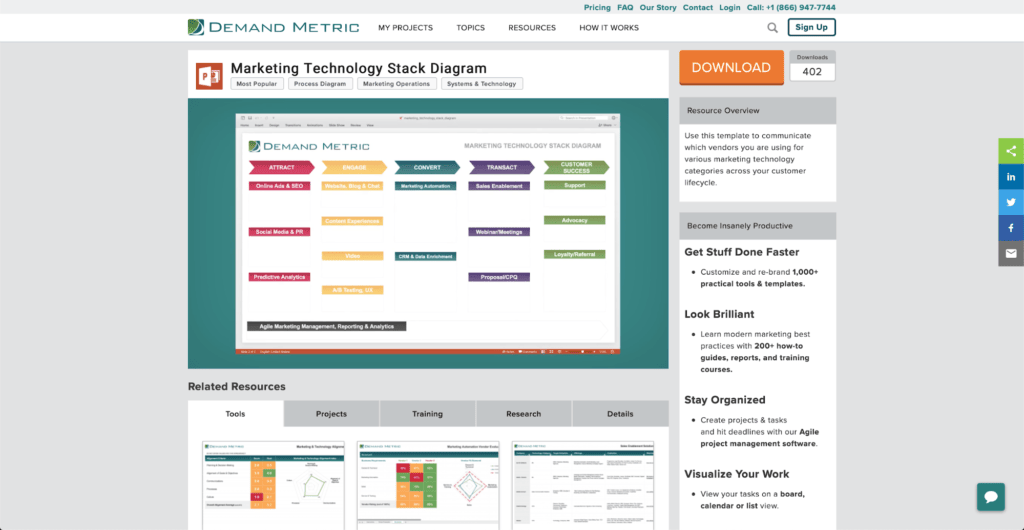
This marketing technology stack diagram, from Demand Metric, makes it easy for marketing operations professionals to communicate clearly about which tools they are using.
Segment

Segment is a platform that collects user events from all your web and mobile apps, and then gives you a complete data toolkit. That toolkit gives marketing a single view of their customer, as well as real-time audience information.
Key features
- Unifies customer touch points across all channels
- Integrates with your key tools
- Uses a single API for cleaner code
3. Brand compliance
Marketing ops professionals also need to ensure brand compliance. Marketing ops usually rely on software, in order to achieve this task. The following software solutions help your marketing organization to deliver a consistent brand strategy across all your regions.
Consistent review process
Reinforcing marketing strategy and ensuring brand compliance is only possible when marketing ops professionals set up a reliable content review and approval process. The process ensures that important stakeholders act as reviewers of written or visual content. Once marketing operations management sets up this process, you can be sure that all details are taken care of – for a consistent and strong brand message.
Filestage: Content compliance

Filestage is a review and approval platform for marketing and creative teams. This tool makes it easy to share, review, and discuss any type of content with all your stakeholders in one place. Just set up a process with multiple review steps that your content has to go through, to make sure it gets approved by the right people. This way, you ensure it meets all quality, brand and compliance requirements, before it gets published.
Key features
- Supports all common file types of documents, images, videos, and audio
- Leave and discuss feedback directly on the file
- Collect all comments in one place (get rid of long email threads)
- Invite as many reviewers as you like; they don’t need to log in
4. Marketing projects and process management
Templates help you structure all your marketing campaigns, from start to finish. The following sections describe the best marketing campaign templates you can use, for a wide range of purposes.
Project plan template by Filestage
Even though each project differs, there are certain ingredients, which look alike across virtually all projects. The project plan template from Filestage structures your project according to goals, scope, task scheduling, communication, and resources. This template will help you plan and execute your campaigns much more efficiently. Download it here.
Asana

Asana aims to simplify team-based work management. It is one of the world’s most popular project management platforms and collaboration tools. Marketing ops managers around the world use this tool to organize and plan marketing workflows, projects, and more.
Key features
- Integrates with key platforms
- Simple to use and onboard team members
- Gives a number of project views
Closing thoughts
Marketing operations deserve your full attention and are the backbone of modern marketing departments. The marketing ops team helps both small and large companies improve all their marketing efforts, from content creation, campaign planning, customer experience and journey to sales and efficient performance measurement. Therefore, marketing managers should take a closer look at the (often underestimated) marketing operations role, to boost performance.










